Unsure about your French table manners? Click Here to download > > How to avoid these 10 food etiquette mistakes !
- Home ›
- Destinations ›
- Lake Geneva-French Alps ›
- Grenoble
16 Reasons Why History Buffs Will Love Grenoble
Published 04 November 2024 by Leyla Alyanak — Parisian by birth, Lyonnaise by adoption, historian by passion
Grenoble, just over an hour from my home, is a dream for history lovers. From Roman walls and 17th-century fortifications to tales of revolution and Resistance, here are 15 compelling reasons for any history buff to fall in love with this ancient yet energetic city.
Grenoble is the jumping off point for many of the French Alps’ great ski resorts, not to mention a world-class research center. What is less known is the incredibly rich history that hides among its streets and buildings.
Once part of the Kingdom of Burgundy, the region that became known as the Dauphiné joined France in 1349. Its spirit of resilience − honed during its days as a fortified town − threads through its history, from the violent protests during the French Revolution to the city's role as a hub of the Resistance during World War II.
If you love history, you'll find plenty of it here.
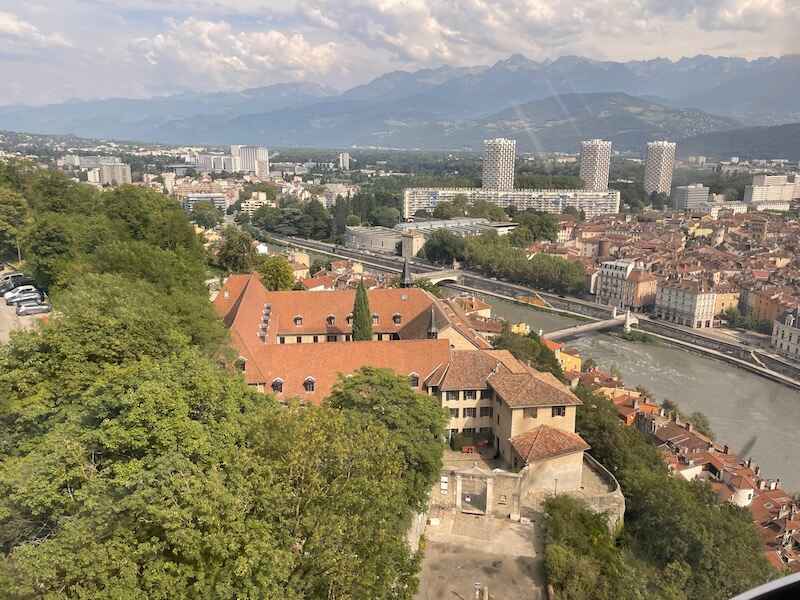 Grenoble, between river and mountains ©OffbeatFrance
Grenoble, between river and mountains ©OffbeatFrance1. Cularo to Grenoble: The Ancient Roots of a Modern City
2. Saint-Laurent Archeological Museum − 2000 years of history
3. Grenoble’s Golden Age: How a 17th-Century Duke Transformed the City
4. Lesdiguières’ Legacy: The Bastille Fortress Above Grenoble
5. Jardin de Ville: Lesdiguières was not just the Bastille
6. A Day of Tiles: How Grenoble’s Revolt Sparked the French Revolution
7. The Linguist Who Deciphered Hieroglyphics: Champollion’s Grenoble Connection
8. Grenoble, Glove-Making Capital of the 19th Century
9. Antiques and Artisans: Exploring Grenoble’s Craftsmanship Legacy
10. Rue Voltaire’s Secrets: The Lost Fireplace Admired by King Henry IV
11. Rue Neuve: The Hidden Wealth of Grenoble’s Noblesse de Robe
12. Place aux Herbes: The Marketplace Tradition of Grenoble’s Historic Square
13. Place Saint-André, anchoring Grenoble's history
14. From Convent to Bookstore: Ste. Cécile’s Unique Literary Transformation
15. Capital of the Maquis: Grenoble’s Pivotal Role in the French Resistance
16. From Quiet Town to Olympic Hub: The 1968 Games That Changed Grenoble
NOTE: Pages on this site may contain affiliate links, which support this site. See full Privacy Policy here.
Historical secrets of Grenoble
Today, while Grenoble is known for its cutting-edge technology, it hasn’t lost any of its historical appeal. Here are plenty of sights that will whet your historian's appetite and unveil the city's past − and its present.
1. Cularo to Grenoble: ancient roots of a modern city
Grenoble started life as the Gaulish village Cularo before becoming a Roman city in the 3rd century. It surrounded itself with protective walls to defend against barbarian invasions, and these original Roman ramparts later shaped the city’s layout.
A few traces of Cularo’s walls remain embedded in Grenoble’s modern structures, in walls and hallways, but they’re not necessarily easy to find.
Some visible stone sections of the Roman wall are preserved along Rue Lafayette, near the Place Grenette, but the best-preserved remnants are in the Musée de l’Ancien Évêché, where you can learn more the city’s Roman history. You’ll also see some on Place Notre-Dame, in the city’s historic center, and if you’re heading to the Bastille fortress, stop by the public garden, the Jardin de Ville.
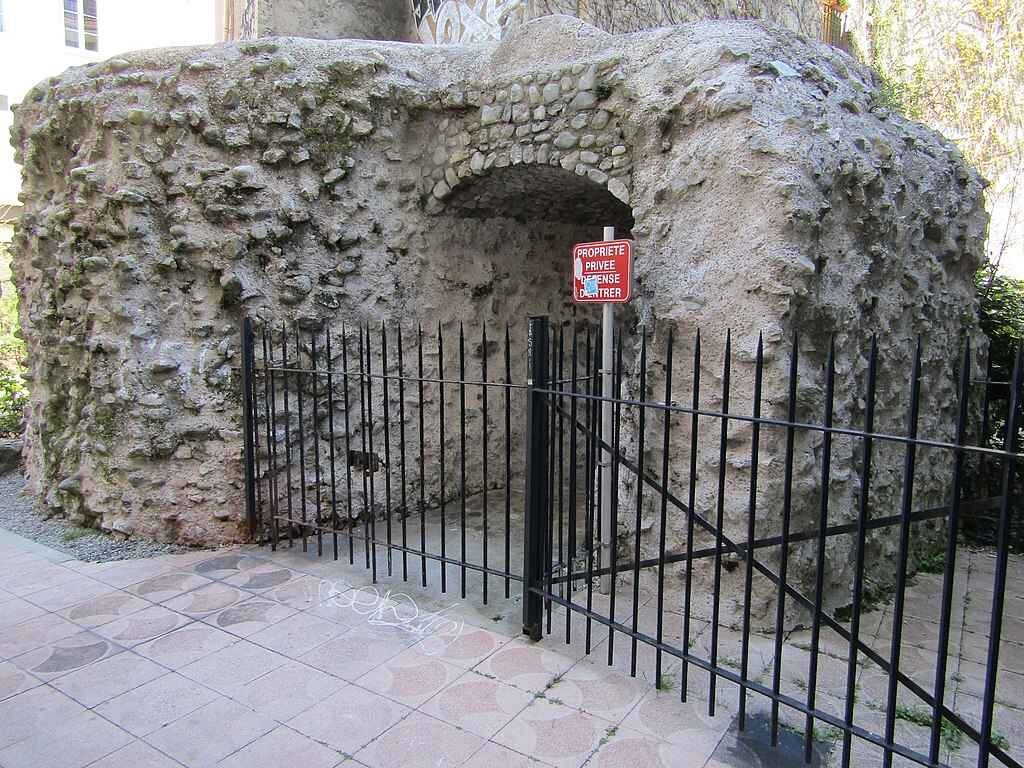 One of the few remaining Roman ramparts in Grenoble by Jean-Paul Corlin, CC BY-SA 4.0 via Wikimedia Commons
One of the few remaining Roman ramparts in Grenoble by Jean-Paul Corlin, CC BY-SA 4.0 via Wikimedia Commons2. Saint-Laurent Archeological Museum − 2000 years of history
If you want to step into Grenoble through its different eras, there’s no better place than the Saint-Laurent Archaeological Museum, housed within a former church that traces its origins back to a 3rd-century Gallo-Roman necropolis.
The building’s foundations are from several different eras, one stacked upon the another, transitioning from pagan to early Christian burial traditions.
Its showpiece is the 6th-century Saint-Oyand crypt, whose beautifully carved stone provides us with a peek into the Early Medieval. The crypt, beautifully conserved, is now accessible beneath a modern glass and steel canopy to help us immerse ourselves in the past.
During excavations for the museum, more than 1500 graves were discovered, the oldest dating back to the 4th century and the most recent to the 18th.
This broad historical sweep has provided us with plenty of knowledge about the evolution of burial methods and funerary practices, which we can also learn about through the many artifacts it displays.
3. Grenoble’s Golden Age: how a 17th-century Duke transformed the city
For years his name was nearly forgotten but these days, he is undergoing a significant revival: François de Bonne, Duke of Lesdiguières, is one of Grenoble’s outstanding historical figures.
A skilled officer, he was also a Huguenot − French Protestant − and defended the Dauphiné region (which included Grenoble) under King Henry IV against pro-Catholic forces during the late 16th-century Wars of Religion. This level of commitment would land him the title of Connétable de France, the country’s highest military grade.
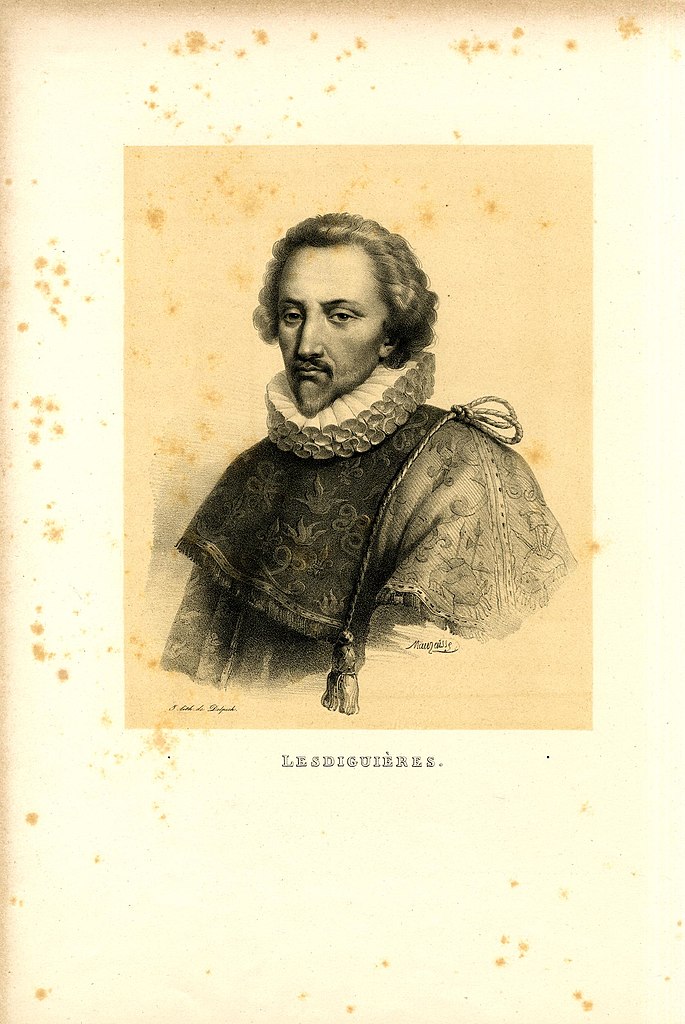 Portrait of François de Bonne, Duc de Lesdiguières, by Jean Baptiste Mauzaisse
Portrait of François de Bonne, Duc de Lesdiguières, by Jean Baptiste MauzaisseHe not only defended Grenoble − he empowered it. He expanded its fortifications, added the imposing Bastille on its hillside, and launched a building spree that changed the face of the city and made it into the region’s premier cultural center.
He actively promoted arts and architecture, adding French-style gardens, ornate façades and stately homes for the nobility. Rumor has it that Lesdiguières was so particular about design he may have dabbled in it a bit himself.
4. Lesdiguières’ legacy: the Bastille fortress above Grenoble
The Bastille may well be the first thing you see in Grenoble.
Perched high above the city, the fortress is reached by cable cars (known as Bulles, or bubbles − it’s easy to see why!)
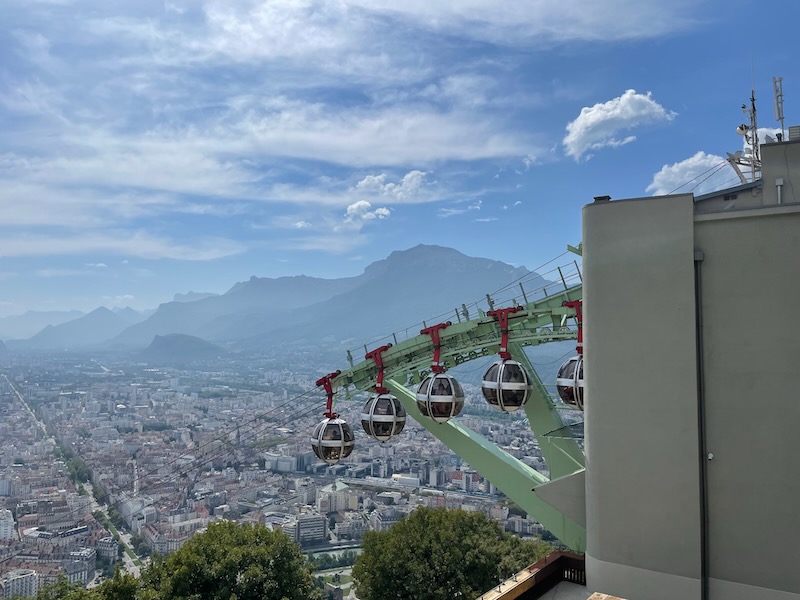 The cable cars, known as “Bulles” or Bubbles, whisk visitors up from Grenoble to the Bastille in four minutes ©OffbeatFrance
The cable cars, known as “Bulles” or Bubbles, whisk visitors up from Grenoble to the Bastille in four minutes ©OffbeatFranceLadiguières saw Grenoble as a city requiring protection against invaders.
There it sits, atop Grenoble, able to see attackers from miles away. As for the fortress itself, its network of walls, barracks and steep paths would give even the hardiest enemies pause. Except that the enemies never came, and the Bastille’s defensive prowess was never tested.
Given as he was to combining military strategy with practical design, it’s easy to imagine Lesdiguières standing proudly atop his fortress, scanning the horizon for enemies while directing the placing of stones and the building of passages.
5. Jardin de Ville: Lesdiguières was famous for more than the Bastille
If you’re looking for Lesdiguières closer to the ground, head for the Jardin de Ville, the public garden which was once a retreat for the nobility. It’s just outside the Roman ramparts, so you’ll be able to see some of those remnants here.
Under Lesdiguières, in 1620, the area was transformed into a magnificent French garden, adding a touch of Renaissance elegance with flower beds arranged in intricate patterns, topiaries, and ornate fountains. His residence, now the Maison de l’International and the city library, was located alongside the garden so he could oversee the grounds.
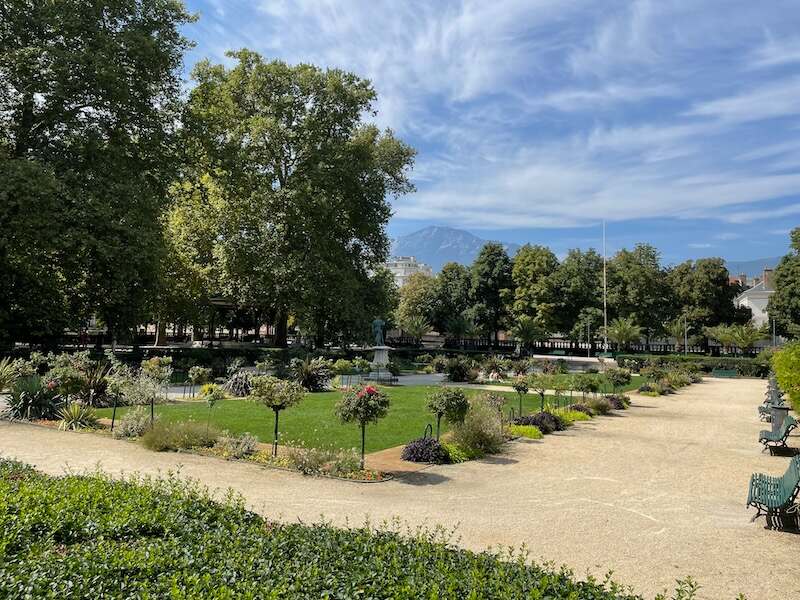 Jardin de Ville, once reserved for Grenoble’s nobility ©OffbeatFrance
Jardin de Ville, once reserved for Grenoble’s nobility ©OffbeatFranceOver time, the Jardin de Ville lost much of its formality and acquired more romantic touches, with shaded paths and stately trees (and even a music pavilion). It eventually fell into disrepair but a restoration in the 1980s revived, preserving Lesdiguières’ legacy.
Today, like any good city park, it is filled with students, picknickers, familiers, young couples...
6. The Day of Tiles: how Grenoble’s revolt sparked the French Revolution
Well, maybe not exactly sparked, but it certainly was one of the first acts of open defiance against the monarchy which, as we know, was eventually overthrown.
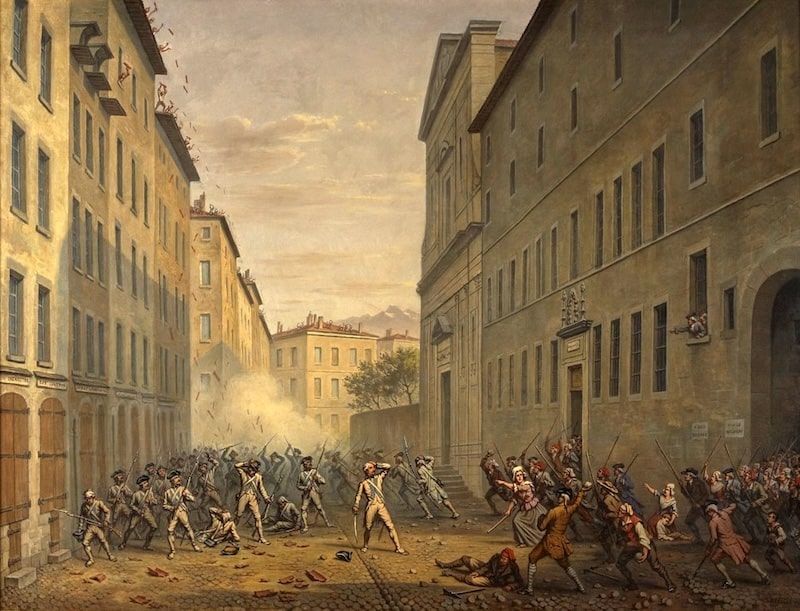 Painting of the Day of Tiles by Alexandre Debelle, CC BY-SA 4.0, via Wikimedia Commons. The painting is now exhibited in the Museum of the French Revolution in Vizille
Painting of the Day of Tiles by Alexandre Debelle, CC BY-SA 4.0, via Wikimedia Commons. The painting is now exhibited in the Museum of the French Revolution in VizilleThe event started, as many things do, with taxes. Louis XVI had imposed yet another round and the people of Grenoble, already heaving under the strain of taxation, dug in their heels and said No.
It was June 1788, and the streets of Grenoble erupted into what became known as the Journée des Tuiles or “Day of Tiles,” as the Grenoblois climbed onto the rooftops and hurled tiles onto the soldiers below.
The soldiers retreated, of course, and the rebellion made Grenoble a symbol of defiance against royal authority.
News of the revolt spread, and soon the Three Estates (a sort of parliament with representatives of the nobility, clergy, and commoners) were summoned to nearby Vizille. It was a historic meeting that laid the groundwork for the French constitution and began what would eventually evolve into the French Revolution.
7. The linguist who deciphered hieroglyphics
Napoleon became fascinated with Egypt during his campaigns there, bringing back many artifacts and fueling European interest in the country.
His troops discovered the Rosetta Stone, which had a single text in three different scripts. This remained undecipherable until… the Grenoble-born linguist and historian, Jean-François Champollion, made it his mission to reveal its secrets.
Champollion wasn’t just any linguist. A true prodigy, he was already fluent in Latin, Greek, and Coptic by the age of 12, skills that would be useful in a Europe besotted with Egypt.
His eventual breakthrough in decoding the stone’s inscriptions earned him the title “Father of Egyptology” and reshaped scholars’ understanding of Egyptian civilization.
Grenoble, much accustomed to academic brilliance, is rightfully proud of this native son, who is honored at the Musée Champollion, south of Grenoble, in his old family property.
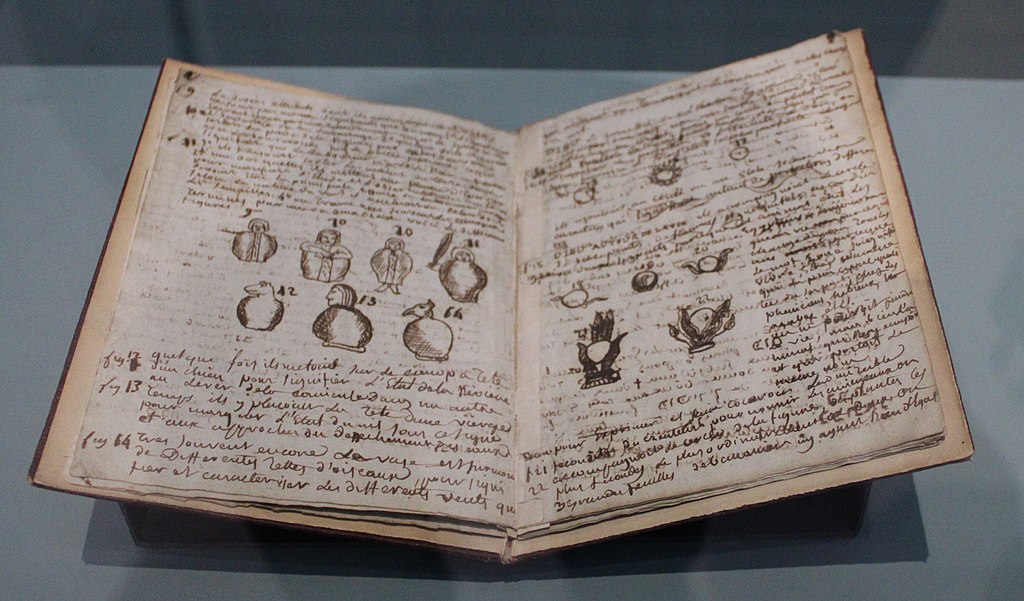 One of Champollion’s notebooks, held in the Louvre-Lens Museum. Photo René Hourdry, CC BY-SA 4.0 via Wikimedia Commons
One of Champollion’s notebooks, held in the Louvre-Lens Museum. Photo René Hourdry, CC BY-SA 4.0 via Wikimedia Commons8. Grenoble, glove-making capital of the 19th century
Did you know that Grenoble was once the luxury glove capital of the world?
The city's reputation for glove-making stretches back to 1328, but it really came into its own in the late 18th century, when fine gloves were crafted for high society across Europe and beyond. At the time, more than a million pairs came out of Grenoble’s workshops each year.
At one point, half the families in Grenoble depended on the glove industry, but the industry began to fadew. Fewer people were wearing gloves, and mass production, particularly in Asia, brought prices down: the craftsmen of Grenoble couldn’t compete.
Today, a single glove-maker remains in Grenoble: Jean Strazzeri, head of Ganterie Lesdiguières-Barnier. What with growing disenchantment with mass-produced goods and a yearning and renewed appreciation for traditional craftsmanship, who knows what might happen in future…
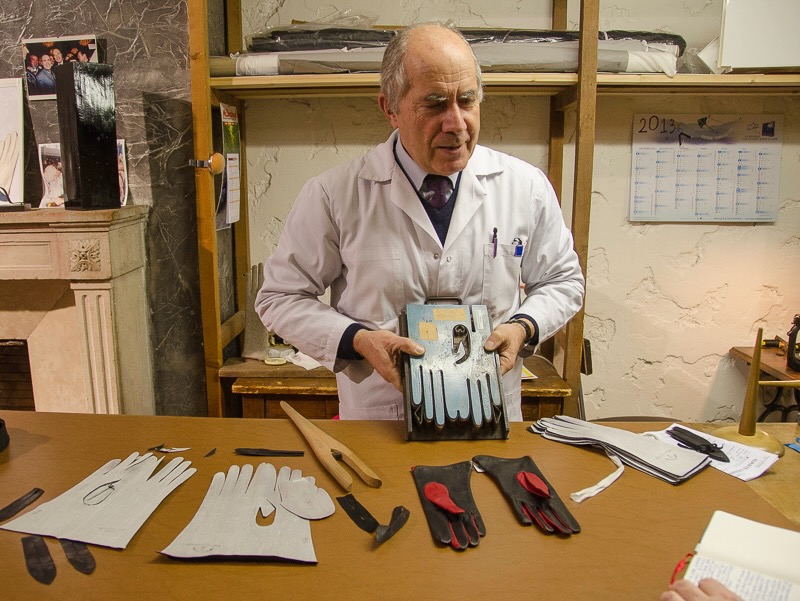 Jean Strazzeri, Grenoble’s last artisan glove-maker, heads the Ganterie Lesdiguières-Barnier ©OffbeatFrance
Jean Strazzeri, Grenoble’s last artisan glove-maker, heads the Ganterie Lesdiguières-Barnier ©OffbeatFrance9. Antiques and artisans: exploring Grenoble’s craftsmanship legacy
The workshop of Grenoble’s last glove-maker is located in the Quartier des Antiquaires, or the Antiques Quarter.
If you're looking for craftsmanship and history, this is where you want to be.
Of course you'll find plenty of antique shops here, filled with old furniture, often recently acquired from families selling their ancient homes or opting for more modern conveniences.
You'll also find plenty of art galleries, boutiques, second-hand stores and workshops – it’s a little enclave that feels different from the rest of the city (and you may come upon the occasional flea market too).
10. Rue Voltaire’s secrets: the lost fireplace admired by King Henry IV
While you're in the neighborhood, this Renaissance street’s façades hide a mystery.
In this case, that mystery is a fireplace.
According to legend, King Henry IV once visited the home of Pierre Bucher, where he was captivated by an especially magnificent fireplace. This made Bucher nervous, however: what if the King wanted it for himself? How could he refuse?
Bucher decided to hide the fireplace entirely, concealing it so well no one has found it yet. It might be behind a wall, under a floor, or maybe it was even moved to another location.
Whenever you pass an ancient doorway or brick wall along the rue Voltaire, who knows, it just might hide the famous chimney.
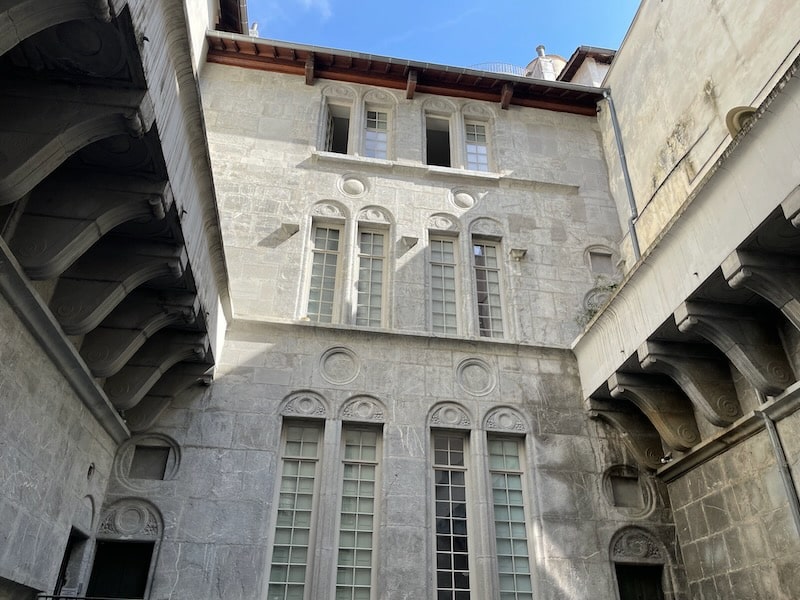 Who knows whether the fireplace is still in there, somewhere... ©OffbeatFrance
Who knows whether the fireplace is still in there, somewhere... ©OffbeatFrance11. Rue Neuve: the hidden wealth of Grenoble’s noblesse de robe
During the 17th century, Rue Neuve was where Grenoble’s "noblesse de robe" lived (these were nobles whose titles came from earning a high office rather than through heredity).
It looks modest at first, but behind discreet doors is a quiet luxury, opulent interiors and private gardens where nobles could escape public view.
Step through a doorway, and you’ll find yourself in a world of grandeur, with intricate woodwork and wide staircases designed for noblewomen’s voluminous skirts. Some homes also feature trompe l’oeil windows to create an illusion of more space or to hide staircases and servant areas.
In other words, a street with secrets.
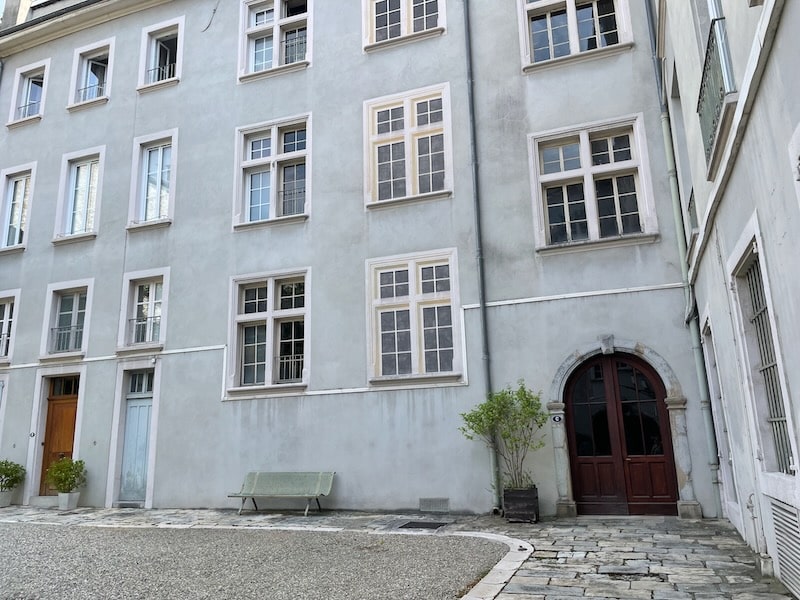 Not all these windows are real...
Not all these windows are real...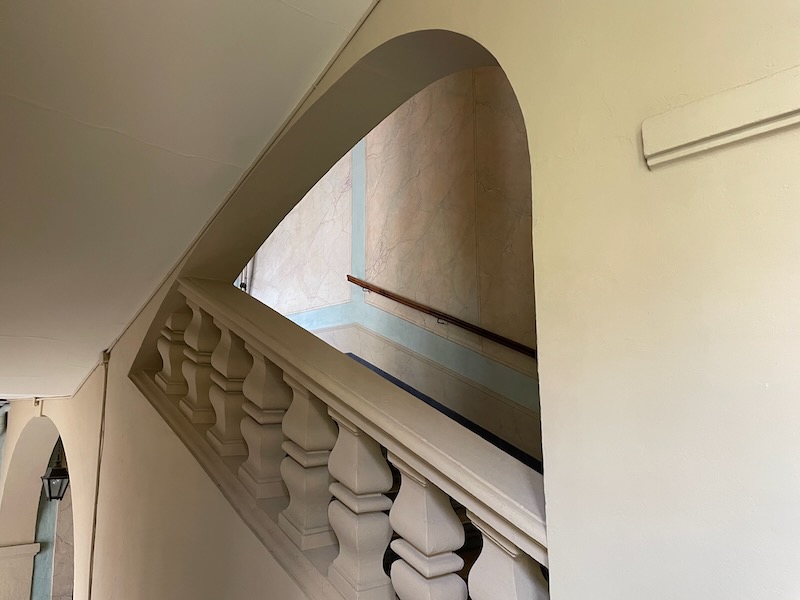 The stairways in some nobles’ homes were wide enough to accommodate the large skirts of the time without snagging on the wall ©OffbeatFrance
The stairways in some nobles’ homes were wide enough to accommodate the large skirts of the time without snagging on the wall ©OffbeatFrance12. Place aux Herbes: a marketplace tradition
Of course Grenoble has a traditional market place: Place aux Herbes, which has been active for several centuries.
Like most markets in France, it’s also a meeting place, where neighbors catch up and friends stop a moment for coffee.
Before being a market, it was where the Great Council met, outdoors, sitting on benches.
It also happens to be at the highest point of Grenoble, and because the city was once prone to flooding, the lower storeys of houses up here are built of massive stone…
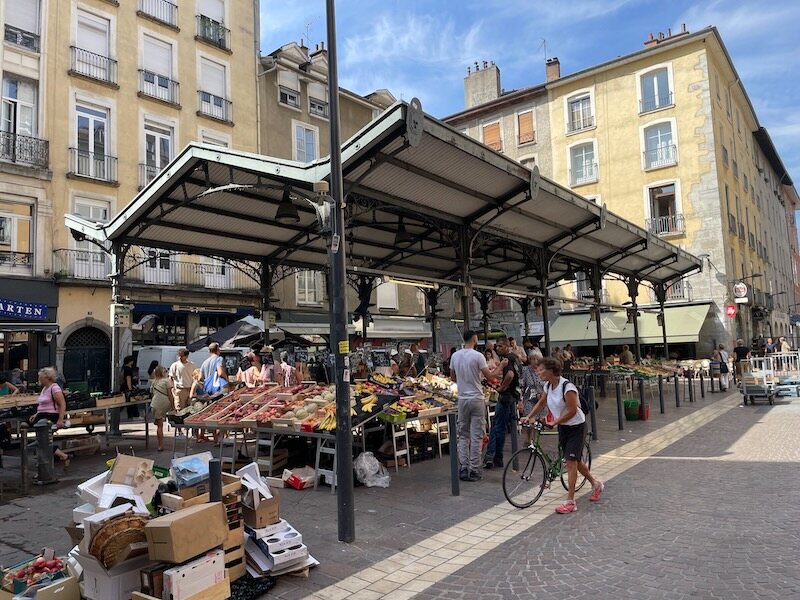 Place aux Herbes, home of Grenoble’s ancient market ©OffbeatFrance
Place aux Herbes, home of Grenoble’s ancient market ©OffbeatFrance13. Place Saint-André, anchoring Grenoble history
Place Saint-André is a bit where history converges in Grenoble, with the city's medieval and revolutionary pasts sharing the space.
Anchored by the striking Parlement du Dauphiné, a Gothic building that once housed the regional parliament, the square has seen pivotal events like the 1788 Day of the Tiles. It is also home to the imposing Church of Saint-André, built in the 13th century.
This is also where you'll find the Café de la Table Ronde, one of France’s oldest cafés (and the oldest in Grenoble), where figures like Stendhal gathered to debate art and politics. Of course I had to sample lunch here, hearty traditional food at reasonable prices.
Table Ronde means roundtable. All the tables are square...
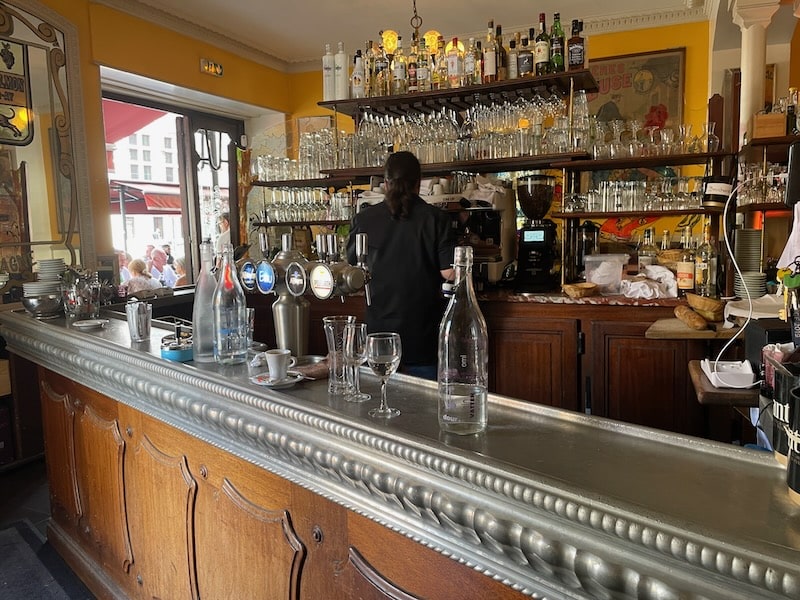 Like many cafés of a certain age, it hides a beautiful zinc bar... ©OffbeatFrance
Like many cafés of a certain age, it hides a beautiful zinc bar... ©OffbeatFrance14. From convent to bookstore at Ste. Cécile
This is one of my favorite spots in Grenoble: a convent turned manga and comic-book editor and art exhibition.
Sainte-Cécile, once a place of quiet contemplation, now houses over 37,000 books along walls that are still covered with works of religious art.
Founded in 1624, it was first a convent, then a barracks, a cinema, a theater… Today, the Glénat publishing house has taken it over and somehow, it still feels like a sacred venue, quiet and spiritual, unlike what you’d expect from a publisher who specializes in cartoons for all ages...
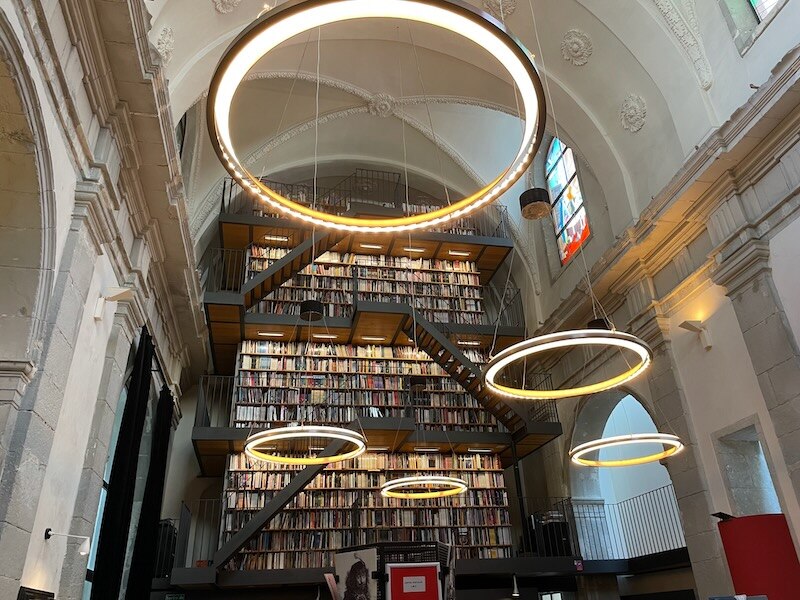 The former Convent of Sainte-Cécile, now a bookstore and publishing house ©OffbeatFrance
The former Convent of Sainte-Cécile, now a bookstore and publishing house ©OffbeatFrance15. Capital of the Maquis: Grenoble’s role in the French Resistance
During World War II, Grenoble’s rugged, remote mountains became a natural refuge for the maquis, the courageous Resistance fighters who waged a guerrilla war against Nazi forces.
Grenoble was known as the “capital of the maquis” as locals risked their lives to sabotage the occupation, protect Jewish families, and help Allied soldiers. It was a perfect place for clandestine action, given the landscape.
Grenoble’s Museum of the Resistance and Deportation is well worth seeing: it houses items like cell doors from Gestapo prisons, tools used to create false identity papers, and a memorial to the Jewish children of Izieu who were hidden in the mountains.
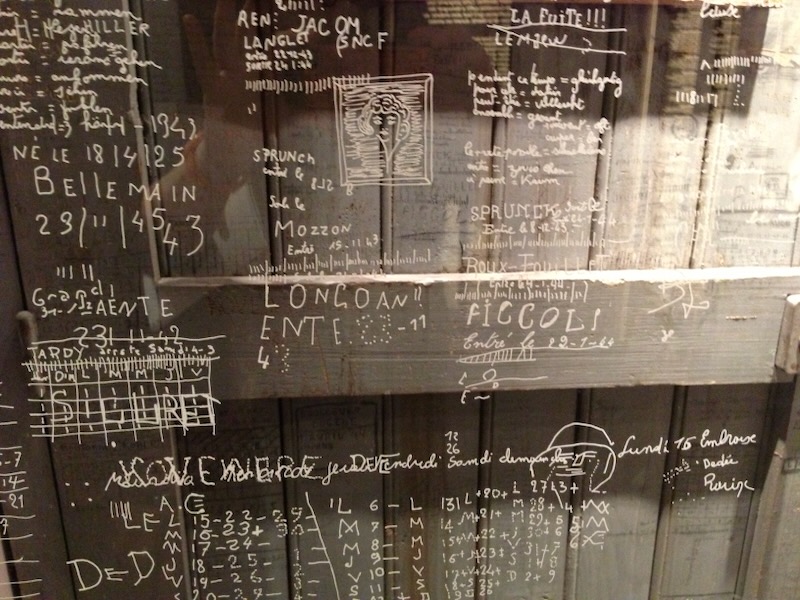 Replica of what prisoners of the Gestapo wrote on their cell walls displayed in the Museum of the Resistance and Deportation ©OffbeatFrance
Replica of what prisoners of the Gestapo wrote on their cell walls displayed in the Museum of the Resistance and Deportation ©OffbeatFrance16. The 1968 Games that changed Grenoble
In 1968, Grenoble underwent a metamorphosis.
Thanks to the Olympic Games, the city doubled in size, building new sports facilities, hotels and modernizing transportation.
And you can still see signs of it: the Palais des Sports hosts concerns and games, and the Olympic Village is now residential housing.
The Bubbles, the city’s iconic cable cars, were also a product of the Olympics, making access to the Bastille easy.
This quiet Alpine town, once known for its scenery and historical charm, suddenly became an international hub as thousands of athletes and tourists poured in. You could say the Games put Grenoble on the map.
Before you go...
This is a region mostly explored in winter, because of its fabulous ski resorts, but the rest of the year is also stunning.
If you're in Grenoble, you won't be far from the Lake Geneva area, so here's a one-week road trip to show other parts of this alpine region.

